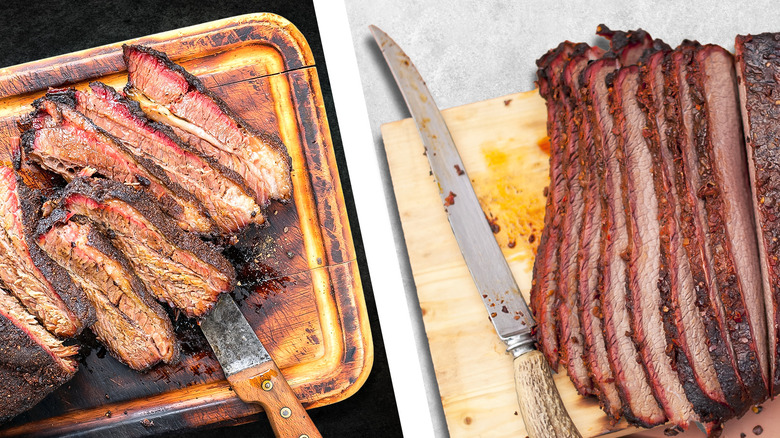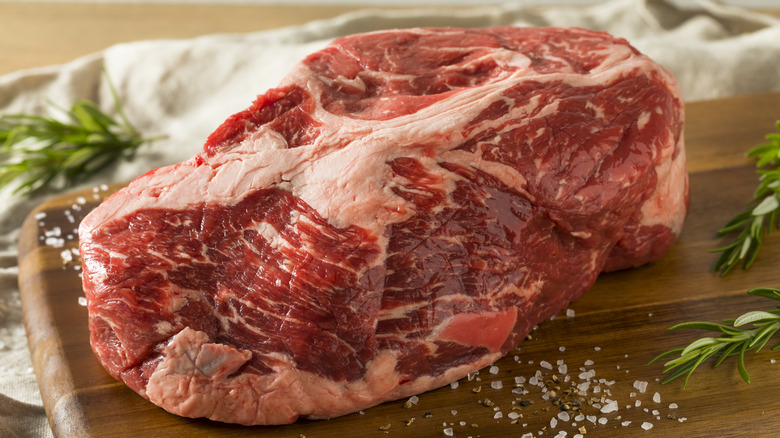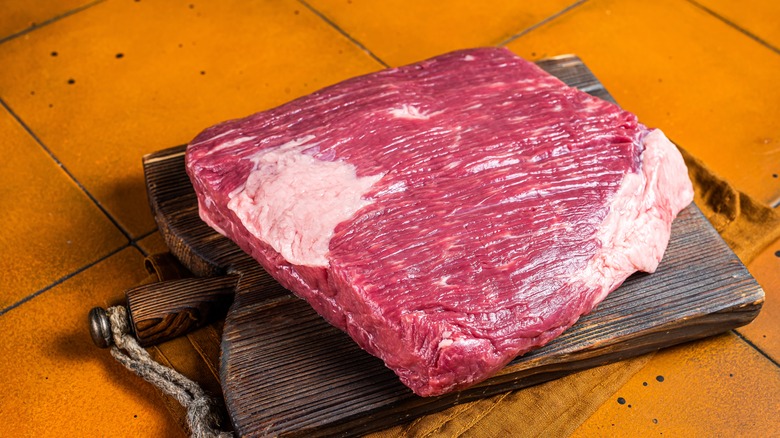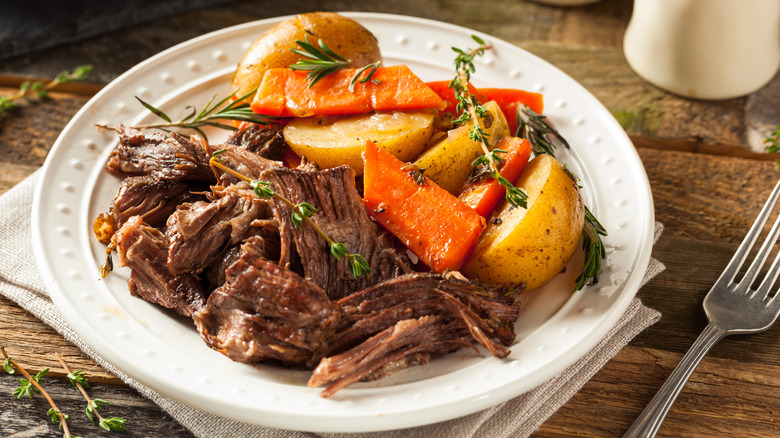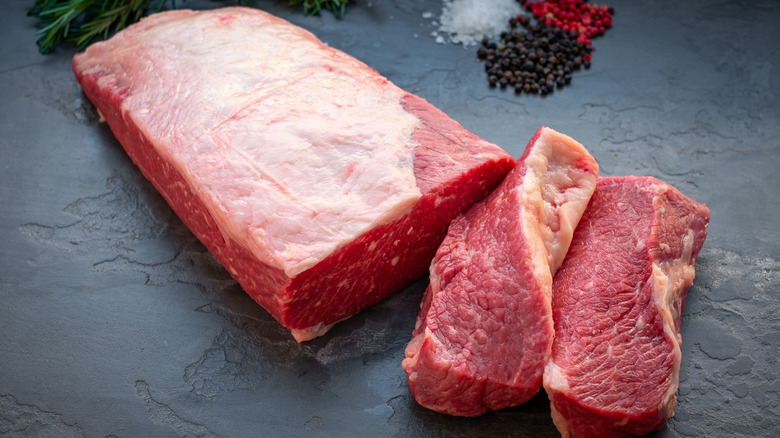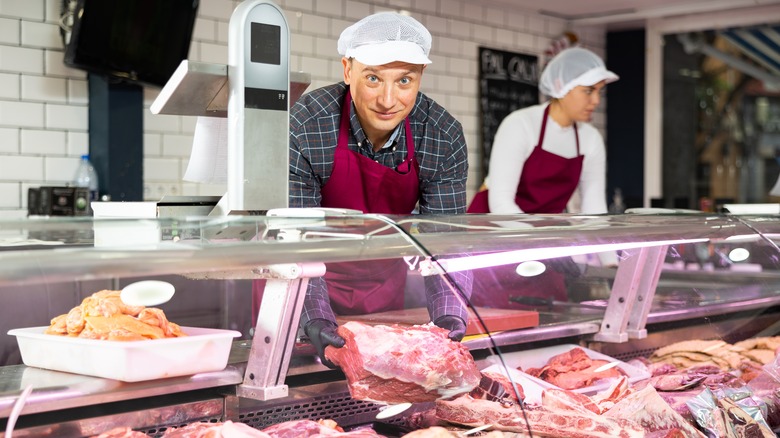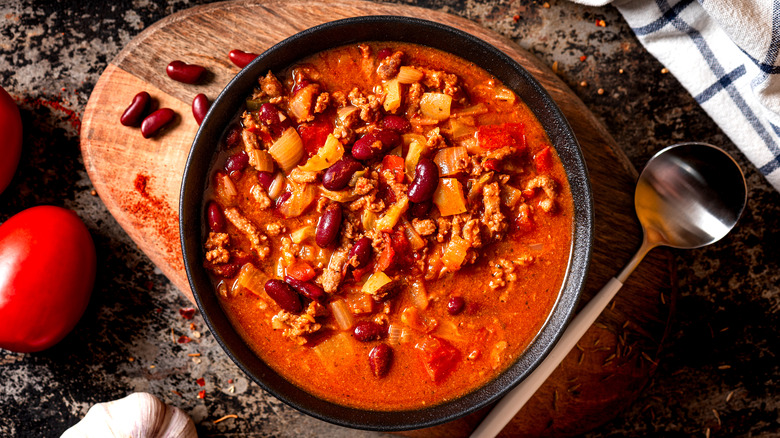The Important Differences Between Chuck Roast And Beef Brisket
If you are a normal shopper just looking to make a roast and not an expert, the differences between cuts of beef can be one of the most confusing things to wrap your head around. Chicken parts are simple to classify, and while pork is a little more complicated, the difference between tenderloin and chops is pretty easy to learn. But beef can be broken down into dozens of cuts, many of which look similar to a novice, and then gets even more difficult when you learn a lot of those cuts can go by two or more names for the same thing. Even if you know one cut is more "well-marbled," or where on the cow it comes from, what does that mean for your steak or pot roast? Sometimes two cuts that seem the same can have meaningful differences, and that is definitely the case with chuck roast and beef brisket.
Chuck roast and brisket are both large cuts of beef that are usually slow-cooked. Brisket is a primal cut from the chest of the cow, above the two front legs, while chuck roast comes from the shoulder area. Both chuck roast and brisket can be lean, and they get tough if cooked too quickly, but under the surface, they vary quite a bit in their flavor, texture, and the kind of recipes they work best in.
What is chuck roast?
Chuck roast can refer to a few different cuts of beef from the chuck part of the cow. Like brisket, beef chuck is a primal cut, which means it's a large section that is then broken down into more specific cuts. The chuck is a big area, ranging across the neck, upper arms, and shoulder of the cow. Chuck is known for its rich flavor, but because it's an area of the cow that does a lot of work, it's also filled with collagen and connective tissue, which can make it tough to cook. This combination has made chuck popular for ground beef, which keeps the taste but breaks up the tissue. It also gets broken down into a variety of roasts, which are popular for slow cooking.
A chuck roast can come from different parts of the chuck like the neck or the "chuck-eye," which is cut from the upper shoulder. Technically any bigger piece of beef from the chuck meant to be roasted can be called "chuck roast," so there can be some variations in their fat, and tenderness. But no matter where your chuck roast comes from, they are large, affordable cuts of beef that contain lots of connective tissue and some fat.
What is beef brisket?
Brisket is composed of cuts from the pectoral area of the cow. Although not as large as the chuck, it's still sizeable and gets broken down into two types of cut. There is the brisket flat or "first cut," which is more lean, uniform in shape, and popular for slow cooking, especially braising, which helps add moisture to the dry meat. The second cut is the "point," and is more fatty and marbled. The flat is what is usually turned into corned beef, while the point is popular for smoking and barbecue. The individual cuts are usually quite large themselves, and you don't see brisket steaks in stores very often.
Similar to chuck, brisket comes from a section of the cow that sees a lot of movement and work as it supports up to 60% of the cow's weight, so it has lots of connective tissues and can be quite tough. This means it was historically a cheap cut of beef that needed to be slow-cooked for long periods to become tender and palatable. But that same factor also means it has found its way into lots of beloved traditional dishes like pastrami, from people who found creative ways to prepare this inexpensive meat.
Chuck roast is more fatty and flavorful
Although both chuck roast and brisket have reputations as tough cuts of meat, their similarities start to diverge from there. Areas of the cow that get more work develop more flavor and even though the brisket holds up a lot of weight, no area gets worked during movement like the cow's shoulder. This means chuck roast is incredibly flavorful and beefy. In fact, the part of the chuck most commonly used for roasts is an extension of the ribeye and has a similar taste. Chuck roast also has a decent amount of fat marbled through the meat, which lends it more richness. Overall, that mix of fat and flavor makes chuck roast one of the tastiest cuts of beef you can buy.
Compared to chuck roast, brisket is a little less flavorful and doesn't have the strong beefy taste we associate with steak. Brisket has fat, but it comes in the form of a cap that is mostly outside the cut itself, a lot of which will get trimmed off before cooking. This can add some rich flavor when slow-cooked or smoked as the rendered fat seeps into the meat, but it's not as integrated as with chuck roast, and briskets tightly grouped muscle fibers prevent a lot of the fat from penetrating and flavoring the cut. Most brisket recipes rely a lot on techniques like brining and smoking to add more flavor.
Brisket is tougher and takes longer to cook
Brisket and chuck roast both have plenty of connective tissue, but because it holds up so much weight of the cow, brisket is very tough, even compared to chuck. In fact, the density of muscle fibers in brisket is so high that it makes brisket easy to identify on sight, as it is covered in tightly packed lines all running in one direction up and down the meat. This means that brisket needs to cook even longer than chuck roast for all that tissue to break down and get tender. And, you need to check on it, as it's easier to overcook. Even when it is cooked properly, it has to be sliced correctly as well or it will still be tough. Brisket needs to be sliced across the grain, which means cut perpendicular to the muscle lines, not parallel to them. This breaks up the remaining connective tissue and makes brisket easier to chew.
Chuck roast also has connective tissue, but unlike brisket, it runs through the meat at criss-crossing angles. This makes it tough when kept whole, and harder to cut across the grain. However, the individual sections of meat between the connective tissues are larger and can be quite tender compared to brisket, which is why it gets so meltingly soft when it's broken up by being cubed into smaller pieces and slow-cooked like it often is for stews.
Chuck roast is cheaper and easier to find
Part of both chuck roast and brisket's appeal is that they are relatively affordable cuts of beef, although brisket has been rising in price recently and isn't quite the steal it used to be. The increasing enthusiasm for barbecue brisket, both in restaurants and for home cooks, has driven up demand for the once-shunned section of beef and pushed prices higher. Brisket is also harder to scale up to meet demand, as a single cow will only produce two usable cuts, while the chuck is big enough to produce 12 or more roasts per cow. This has led to brisket becoming more expensive than chuck roast, usually being around $8 per pound to chuck roast's $6, on average. Brisket is still cheap compared to a lot of cuts like ribeye and strip steak that are frequently over $10 a pound, but it has moved up to a mid-tier price point with options like flank steak and sirloin, making it less of a budget buy.
Chuck also has the advantage of being easier to find. Because chuck roasts are smaller, and have such a wide range of uses, including in ground beef, it is very common in most standard grocery stores. The size of brisket, with even the smaller cuts being eight pounds or more, and the lack of supply, means likely you'll have to go to a butcher or specialty grocer to find one, especially if you live somewhere where it's less of a staple.
Brisket is a barbecue staple
The differences in texture between brisket and chuck roast mean they have become favorites in different types of recipes. Brisket may take longer to cook, but that's why it's so beloved in barbecue and smoking, where it can take 12-plus hours to finish. Brisket may not have much marbling, but cooked that long the connective tissue will turn to gelatin, and bring a similar juicy flavor. The classic barbecue brisket is from Texas, where the flavors are often nothing but smoke, salt, and pepper. Of course, you can add your own dry rub, and even use some barbecue sauce if you like.
If you don't have time for a whole day of smoking, the most popular way to cook brisket is braising. Make it like a pot roast with beef stock or red wine and vegetables, and save the liquid to moisten the sliced meat once it's finished. You can do this in a Dutch oven, but a slow cooker is a good option considering how long brisket takes to cook. If you want to mix it up after braising, shredded brisket is frequently used for tacos in Tex-Mex cooking. And hey, if you want to get ambitious you can also make your own homemade corned beef or pastrami. It's a project for sure, but the results will blow most store-bought options out of the water, and you'll have leftovers for days.
Chuck roast is a versatile cut with many uses
Chuck roast's initial toughness, but more fatty, tender finish, makes it a great all-purpose beef cut for any slow cooking recipes. The two most classic uses for chuck roast are in pot roasts and beef stew, where the meat will get buttery and tender. But pretty much any stew-adjacent recipe will work great with chuck roast. You can challenge brisket's Texas supremacy with a bowl of traditional, beanless chili con carne. Chuck roast is also perfect in saucy dishes like goulash or beef stroganoff. And we haven't even mentioned rustic favorites like beef bourguignon.
Moving into different preparations, you can use chuck roast to make shreddable Mexican beef barbacoa for tacos, or beef birria in place of goat. It's an affordable, easy option for beef pot pie and shepherd's pie as well. And if you don't mind a little extra work grinding, chuck roasts' strong flavor and low price point make them a great, common choice to make homemade ground beef for burgers. In fact, one of the best combinations for ground beef is a mix of chuck roast and brisket. Why pit the two against each other when they can live together in harmony?
